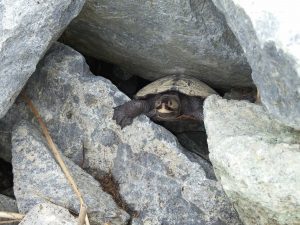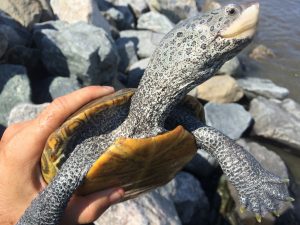DNREC seeks volunteers to help nesting diamondback terrapins along Port Mahon Road near Little Creek
Department of Natural Resources and Environmental Control | Division of Fish and Wildlife | Date Posted: Wednesday, May 10, 2017
Department of Natural Resources and Environmental Control | Division of Fish and Wildlife | Date Posted: Wednesday, May 10, 2017
Division of Fish & Wildlife training to be held May 18 on new turtle tunnels
DOVER – Diamondback terrapins are reptilian icons of Delaware’s Bayshore, Inland Bays and tidal creeks. They spend their lives in brackish waters, but every spring female terrapins leave the water to lay eggs.


This year, DNREC’s Division of Fish & Wildlife is seeking volunteers to ensure terrapins are successful in their journey toward reproduction at one of many places they come ashore to nest: along the Delaware Bayshore’s Port Mahon Road near Little Creek. Fish & Wildlife staff will offer volunteer training beginning at 5:30 p.m. Thursday, May 18 on Port Mahon Road. In the event of inclement weather, training may be rescheduled.
At the peak of nesting season, hundreds of terrapin heads can be seen in the water off Port Mahon as they approach the shoreline. Then, when the tides, temperature and humidity are right, the female terrapins come ashore to lay their eggs.
Port Mahon Road snugly borders the bay in some locations and is often flooded with water and debris during high tides and storm events. Starting in 2015, large rocks were placed along sections of Port Mahon Road to protect it from erosion and debris accumulation. Unfortunately, these rocks can trap terrapins as they leave the water to nest and when making their way back to the bay after laying eggs. Terrapins blocked by the rocks also spend more time in the road where they risk being hit by cars.
To help the terrapins cross the road safely, the Delaware Department of Transportation has constructed two “experimental terrapin tunnels” – wide concrete pipes that run under the rocks to provide the terrapins with safe passage between the bay and their nesting areas. Although similar devices have been successful in other locations, this will be the first nesting season with these structures in place at Port Mahon, so the Division of Fish & Wildlife is seeking volunteers to monitor terrapins and their use of the tunnels, and to assist them as needed.
“With only two test tunnels in place, many terrapins may not be close enough to use one, so volunteers are needed to help the terrapins navigate into the tunnels or around the rocks,” said Wildlife Biologist Holly Niederriter, Division of Fish & Wildlife. “If terrapin passage through the tunnels appears to be successful, additional tunnels may be added along the road in the future.”
If you are interested in volunteering, please contact Chase McLean at 302-735-8669, or email chase.mclean@delaware.gov.
Vol. 47, No. 102
-30-
Related Topics: volunteers, wildlife
Keep up to date by receiving a daily digest email, around noon, of current news release posts from state agencies on news.delaware.gov.
Here you can subscribe to future news updates.
Department of Natural Resources and Environmental Control | Division of Fish and Wildlife | Date Posted: Wednesday, May 10, 2017
Division of Fish & Wildlife training to be held May 18 on new turtle tunnels
DOVER – Diamondback terrapins are reptilian icons of Delaware’s Bayshore, Inland Bays and tidal creeks. They spend their lives in brackish waters, but every spring female terrapins leave the water to lay eggs.


This year, DNREC’s Division of Fish & Wildlife is seeking volunteers to ensure terrapins are successful in their journey toward reproduction at one of many places they come ashore to nest: along the Delaware Bayshore’s Port Mahon Road near Little Creek. Fish & Wildlife staff will offer volunteer training beginning at 5:30 p.m. Thursday, May 18 on Port Mahon Road. In the event of inclement weather, training may be rescheduled.
At the peak of nesting season, hundreds of terrapin heads can be seen in the water off Port Mahon as they approach the shoreline. Then, when the tides, temperature and humidity are right, the female terrapins come ashore to lay their eggs.
Port Mahon Road snugly borders the bay in some locations and is often flooded with water and debris during high tides and storm events. Starting in 2015, large rocks were placed along sections of Port Mahon Road to protect it from erosion and debris accumulation. Unfortunately, these rocks can trap terrapins as they leave the water to nest and when making their way back to the bay after laying eggs. Terrapins blocked by the rocks also spend more time in the road where they risk being hit by cars.
To help the terrapins cross the road safely, the Delaware Department of Transportation has constructed two “experimental terrapin tunnels” – wide concrete pipes that run under the rocks to provide the terrapins with safe passage between the bay and their nesting areas. Although similar devices have been successful in other locations, this will be the first nesting season with these structures in place at Port Mahon, so the Division of Fish & Wildlife is seeking volunteers to monitor terrapins and their use of the tunnels, and to assist them as needed.
“With only two test tunnels in place, many terrapins may not be close enough to use one, so volunteers are needed to help the terrapins navigate into the tunnels or around the rocks,” said Wildlife Biologist Holly Niederriter, Division of Fish & Wildlife. “If terrapin passage through the tunnels appears to be successful, additional tunnels may be added along the road in the future.”
If you are interested in volunteering, please contact Chase McLean at 302-735-8669, or email chase.mclean@delaware.gov.
Vol. 47, No. 102
-30-
Related Topics: volunteers, wildlife
Keep up to date by receiving a daily digest email, around noon, of current news release posts from state agencies on news.delaware.gov.
Here you can subscribe to future news updates.